*NURSING > CASE STUDY > NR-603 Week 6 Mental Health Final Treatment Plan/Analysis – Part 2 | (Psychological trauma, Posttr (All)
NR-603 Week 6 Mental Health Final Treatment Plan/Analysis – Part 2 | (Psychological trauma, Posttraumatic stress disorder)
Document Content and Description Below
Mental Health Final Treatment Plan/Analysis Chamberlain University After further review of this patient being seen in the emergency department for a traumatic incident, I agree with the fo... llowing subject information, objective information, and treatment plan. Patient: C.U. Patient Demographics: Age: 79 y.o Sex: female Race: African American Subject: CC: distressed, delusional, confused, extreme fear and anxiety History: 79-year-old female has been living at her independent living facility since 2010. She is fully functional and independent. She provided care for five years for her husband who recently passed away six months ago. Her only relative is a daughter who talks with her about once a month. Two days ago, her home was broken into, and she was raped and robbed. The housekeeper found her laying on the floor. She was down for two days and was taken to a local hospital. Here, she is distressed, delusional, and is reported to be very emotionally distraught. There are no signs of broken bones or rhabdomyolysis SHx: Marital Status: widowed Children: one daughter Occupation: retired school secretary Living Quarters: independent living facility Tobacco use: Denies Alcohol use: Denies Illicit drug use: Denies PMHx: Chronic conditions are pernicious anemia, osteoarthritis, and urinary incontinence PSHx: hysterectomy Allergies: penicillin Current Medications: Multivitamin one-a-day for women Cyanocobalamin (vitamin B12) 1000mcg Capsaicin topical cream 0.075% ROS: Systemic: Denies fever, chills, or recent weight gain HEENT: Denies headaches, facial pain, or sinus pain. No earache, nasal discharge, nasal passage blockage, or sore throat. Cardiovascular: No chest pain, palpitation, no awakening with shortness of breath, orthopnea, or limb swelling. Pulmonary: Denies wheezing, dyspnea on exertion, shortness of breath, or chest congestion. Mother noted snoring. Gastrointestinal: Denies yellow skin or eyes, a decrease in appetite, difficulty swallowing, heartburn, pain on swallowing, vomiting blood, or melena. Genitourinary: Denies polyuria, dysuria, incontinence, flank pain, and hematuria Musculoskeletal: Denies muscle aches, limb pain, joint pain, or joint swelling. Neurological: confused by the situation, denies syncope, vertigo, dizziness, sensory disturbances, motor disturbances, gait abnormality, or speech difficulties. Psychological: reports excessive worry, extreme fear and anxiety and is emotionally distraught. Skin: Denies redness of the skin, itching, rash, lesions, or nail abnormalities. Objective Physical Exam VS: Heart rate: 115 beats/minute and regular Respiratory rate: 29 breaths/minute Blood pressure: 152/84 mm Hg Oxygen Sat: 98% Room Air Weight: 110 pounds Height: 63 in General: Shows signs of extreme fear and anxiety, is fidgeting on the exam table. She is unable to stop crying, is confused by what is happening, and has blood stains on her clothes near her groin. Neuro: AOx3. Confused about why she is in the Normal hospital strength. No tremors. Normal gait. Cranial nerves: II-XII grossly intact. Unable to look provider in the eyes on examination HEENT: Conjunctivae and lids normal, pupils equal, round, reactive to light and, accommodation, discs sharp and flat, no a/v nicking, hemorrhages, or exudates, normal visual acuity, EOM intact. External ears normal, no lesions or deformities; external nose normal, no lesions or deformities; canals clear bilaterally, tympanic membranes intact with good movement, no fluid; hearing grossly intact bilaterally; nasal mucosa, septum, and turbinates normal. The neck is supple, no masses, trachea midline; no thyroid nodules, masses, tenderness, or enlargement No thyromegaly, adenopathy, or masses. Posterior pharynx without erythema or exudates. Cardiac: S1, S2, regular rhythm, no murmur, rub, or gallop; no thrill or palpable murmurs on palpation, no JVD, no displacement of PMI; no carotid or abdominal bruits; no enlargement of the abdominal aorta. Carotid, radial, posterior tibialis, and pedal pulses 2+ symmetric, no edema Respiratory: Clear to auscultation bilaterally, normal tactile fremitus, no egophony, tycapnea with no use of accessory muscles. Abdominal obese, soft, tender near the suprapubic area, and non-distended abdomen with no masses; bowel sounds active, no liver nodularity or masses, no splenomegaly Skin: diaphoretic, no rash, lesions, ulcerations, subcutaneous nodules or induration, Musculoskeletal: normal alignment, mobility and no deformity of head and neck, spine, ribs, pelvis; standard ROM and 4/5 strength, no joint enlargement or tenderness; no clubbing, cyanosis, petechiae, or nodes of digits and nails. Screening tools: (+) Primary Care PTSD Screen for DSM-5 Pelvic Exam- positive for semen and genital bleeding, pain exhibited during the examination. EKG- Shows sinus tachycardia X- rays- negative for fractures Labs- Pertinent Diagnostic Tests Notes: LABS Chem 10: Na 137, K 3, Cl 104, C02 27, BUN 9, Cr 0.7, gluc 100, Ca 9.8, Mg 1.4, PO4 2.3 6 CBC: WBC 4.3, Hb 13, Hct 32.9, plts 312. Lactate 1 mmol/L Assessment: Differential Diagnosis: Posttraumatic stress disorder, unspecified (F43.10 Posttraumatic stress disorder (PTSD) is a trauma-and stress-related disorder that has historically been detected in combat veterans but also happens after many other traumatic events. The significant signs of PTSD include experiencing a traumatic event; reliving the event or traumatic symptoms; evading of people, places, or things that serve as a reminder of the disturbance; negative disposition and feelings connected with the trauma; and chronic hyperarousal (Watkins, Sprang, & Rothbaum, 2018). Treatment Plan: Referral: Psychologist who can offer trauma-focused cognitive behavioral therapy (CBT). Cognitive behavioral therapy: achieve treatment goals 1. Reduce the severity of symptoms 2. Prevent or treat trauma-related conditions that are existing or may develop 3. Progress functioning coping skills and reestablish a sense of safety and trust 4. Prevent relapse 5. Limit generality of the threat experienced because of the disturbing incident. (American Psychological Association, 2017) Medications: An SSRI like Zoloft will be initiated for depression symptoms. The hyperarousal and sleep issues are controlled by trazodone and can be started at night. RX: Zoloft (sertraline) 50 mg Sig: Take one tablet my mouth once daily Disp: 30 (thirty) Ref: 0 (zero) (Frank, 2014; Epocrates, 2019b) RX: trazodone 25 mg Sig: Take one tablet at night 30 minutes before bedtime. Disp: 30 (thirty) Ref: 0 (zero) (Epocrates, 2019a; Moye & Rouse, 2014) Patient Education: 1. Use the care available from family, friends, and other survivors 2. Re-establish daily habits 3. Express feelings 4. Take time to reflect and recover 5. Do not use drugs or alcohol to help cope 6. Do not make any significant life changes. Please seek professional advice or emergency services: 1. Unable to cope with feelings 2. Not returning to normal after six weeks 3. Experiencing severe problems with sleeping, anger, or social withdrawal 4. Having accidents or work is suffering 5. Using drugs or smoking or drinking excessively in order to cope. 6. Experiencing suicidal ideations (American Psychological Association, 2017) Please follow up with your PCP in one week for them to manage your care. A follow up with PCP will be needed to titrate the new medications prescribed. ANALYSIS: Pathophysiology and Pharmacology: Post-traumatic stress disorder (PTSD) may progress the following contact to one or more disturbing events such as deliberate acts of violence, severe accidents, disasters, or military events. The amygdala is in charge of initiating a fear response in the central nervous system. The brain can monitor the ability to feel fear and then learn to avoid the sensations. Amygdala signals the body via high cortical structures which trigger fear-inducing information. The trigger is done by creating a high association between emotional valence and memory in the cortex. Also, the amygdala can identify danger indicators by the first visual pathways that sidestep the cortex and neocortex. In doing so, the amygdala gages object in their surroundings before interacting with them. The brain can swiftly stimulate almost every body system to exhibit a fight or flight response. The amygdala will also stimulate the hippocampus to help the brain adapt and form new memories related to threats. The significance of the threat followed by reexperiencing, avoidance/numbing, and hyperarousal/hypervigilance establishes vital factors of PTSD (American Psychological Association, 2017). The medications used for this patient, in this case, are appropriate in treating PTSD in elderly patients. An SSIR is the first line treatment for symptoms of PTSD, especially depression and anxiety. Zoloft is a recommended SSRI for geriatric patients because it has fewer side effects. The side effects are due to slower hepatic metabolism and decreased renal clearance experienced in older adults. The trazodone can help with the hyperarousal/hypervigilance that causes insomnia in patients. Both medications are started at a lower dose, and the patient will follow up with their PCP to manage medications/treatment (Moye & Rouse, 2014). Additional analysis of the case: The national guidelines used for the treatment of this patient came from the American Psychological Association. This national group created guidelines that were adopted by providers in 2017. The referral, medication, patient education, and follow up guidelines listed in this treatment plan came from the advice given in this national guideline. The only limitation shown was that this case had to take into consideration the elderly population. Like discussed before, geriatric patients have slower hepatic metabolism and decreased renal clearance. Therefore, medications need to be chosen more carefully. Providers are limited in their choices to help older patients due to many of the side effects of most of the medications that treat PTSD. For example, benzodiazepines are used frequently with adults. However, the extreme sedating side effects, like sedation, can cause significant risk factors for geriatrics (American Psychological Association, 2017; Moye & Rouse, 2014). Follow-up: This patient has a long road to recovery. However, I received a phone call from her PCP stating that she has improved some. She is using her daughter as a support system. They were able to make room at their family home so the mother would not be alone. The psychologist she is seeing has connected her with local support groups which she is going to once a week in addition to therapy twice a week. Her PCP and I disgusted the original plan, and she has been doing well. He mentioned that some nights she still has difficulty sleeping. I suggested increasing the trazodone to a total of 50 mg. The patient can start taking 25 mg thirty minutes before bedtime. After two hours and if sleep has not been achieved then an additional 25 mg can be taken. He agreed with my recommendations and will call the family about the change. Quality: With future cases, pharmacological treatment can be ordered differently. This will depend on the age and comorbidities of the patient. In a healthy adult patient, I would still recommend an SSRI but also give them a benzoxadiazine for as needed anxiety. Healthy adults can handle the metabolism of this drug through their liver and kidneys. Like this case, I would strongly recommend CBT therapy immediately to help with symptoms. Coding and Billing: ICD 10 codes: • Post-traumatic stress disorder, unspecified. F43.11 • Acute stress reaction F43.0 • Insomnia G47.0 CPT: 99291 60 minutes spent with this patient After reviewing this case, a careful treatment plan and analysis is created. An SSRI and trazodone are implemented to help treat this patient’s symptoms experience during the exam. Detailed patient education and thorough follow up plan will help the patient recover successfully. PTSD can cause significant problems for people who experience symptoms. However, with the help of a multidisciplinary team, a patient can fully recover from their traumatic past. References American Psychological Association. (2017, February 24). Clinical Practice Guideline for the Treatment of Posttraumatic Stress Disorder (PTSD) in Adults. Retrieved from https://www.apa.org/ptsd-guideline/ptsd.pdf Epocrates. (2019a). Trazodone Adult Dosing. Retrieved from https://online.epocrates.com/drugs/84/trazodone Epocrates. (2019b). Zoloft Adult Dosing. Retrieved from https://online.epocrates.com/drugs/1443/Zoloft Frank, C. (2014). Pharmacologic treatment of depression in the elderly. Canadian family physician, 60(2), 121-126. Retrieved from https://www.ncbi.nlm.nih.gov/pmc/articles/PMC3922554/ Moye, J., & Rouse, S. J. (2014). Posttraumatic Stress in Older Adults When Medical Diagnoses or Treatments Cause Traumatic Stress. Clinics in geriatric medicine, 30(3), 577-589. doi:10.1016/j.cger.2014.04.006 Watkins, L. E., Sprang, K. R., & Rothbaum, B. O. (2018). Treating PTSD: A Review of Evidence- Based Psychotherapy Interventions. Frontiers in Behavioral Neuroscience, 12. doi:10.3389/fnbeh.2018.00258 [Show More]
Last updated: 2 years ago
Preview 1 out of 8 pages

Buy this document to get the full access instantly
Instant Download Access after purchase
Buy NowInstant download
We Accept:

Reviews( 0 )
$12.50
Can't find what you want? Try our AI powered Search
Document information
Connected school, study & course
About the document
Uploaded On
Sep 07, 2021
Number of pages
8
Written in
Additional information
This document has been written for:
Uploaded
Sep 07, 2021
Downloads
0
Views
176




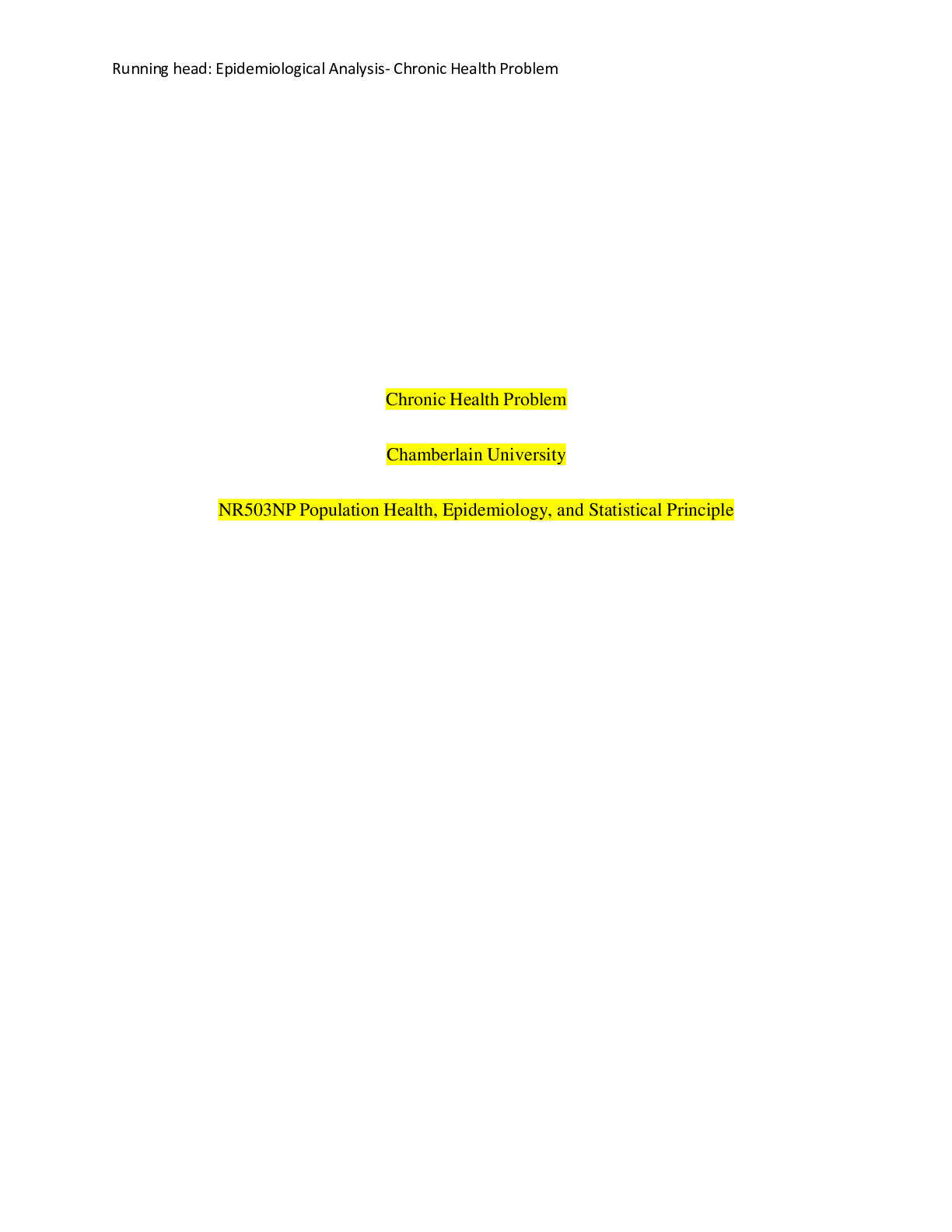
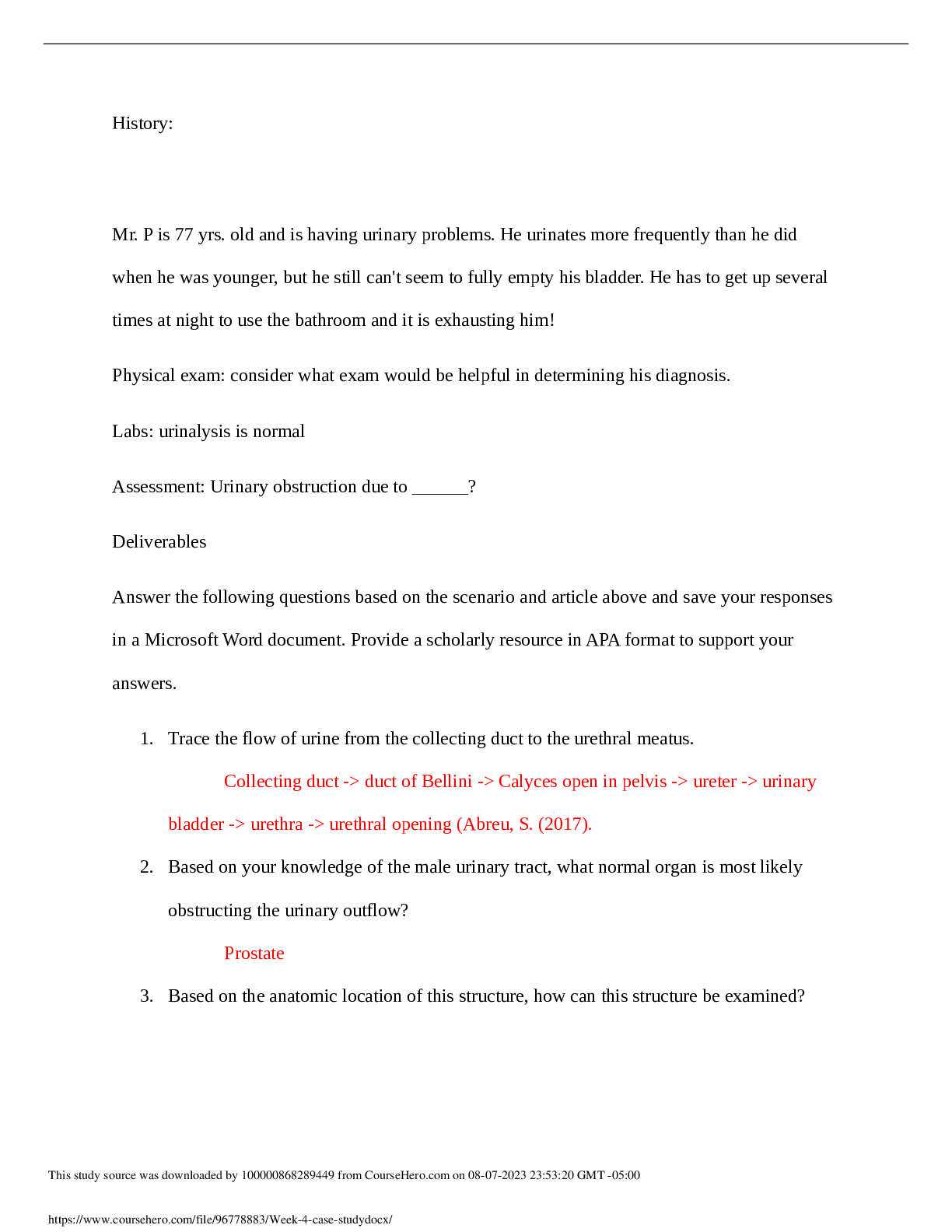

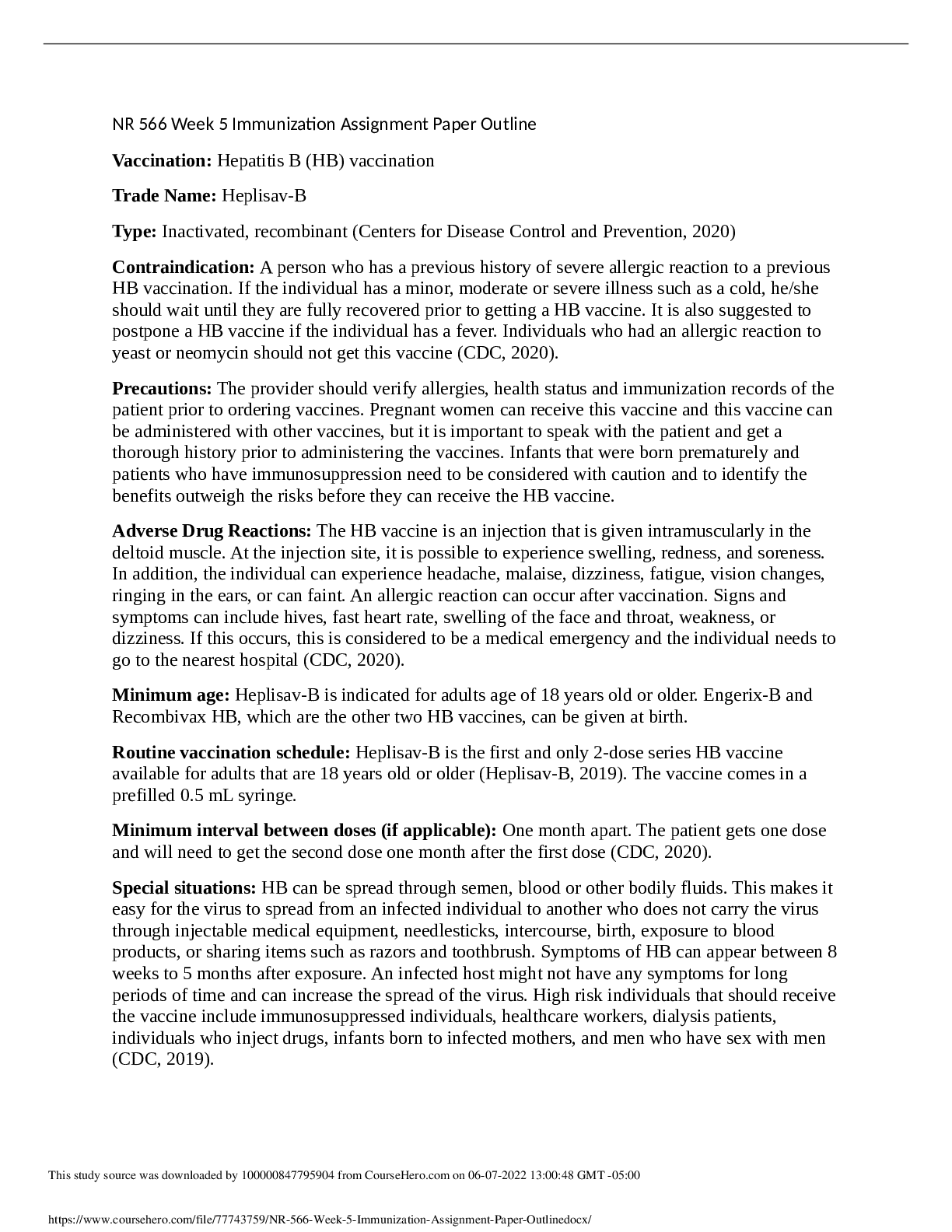
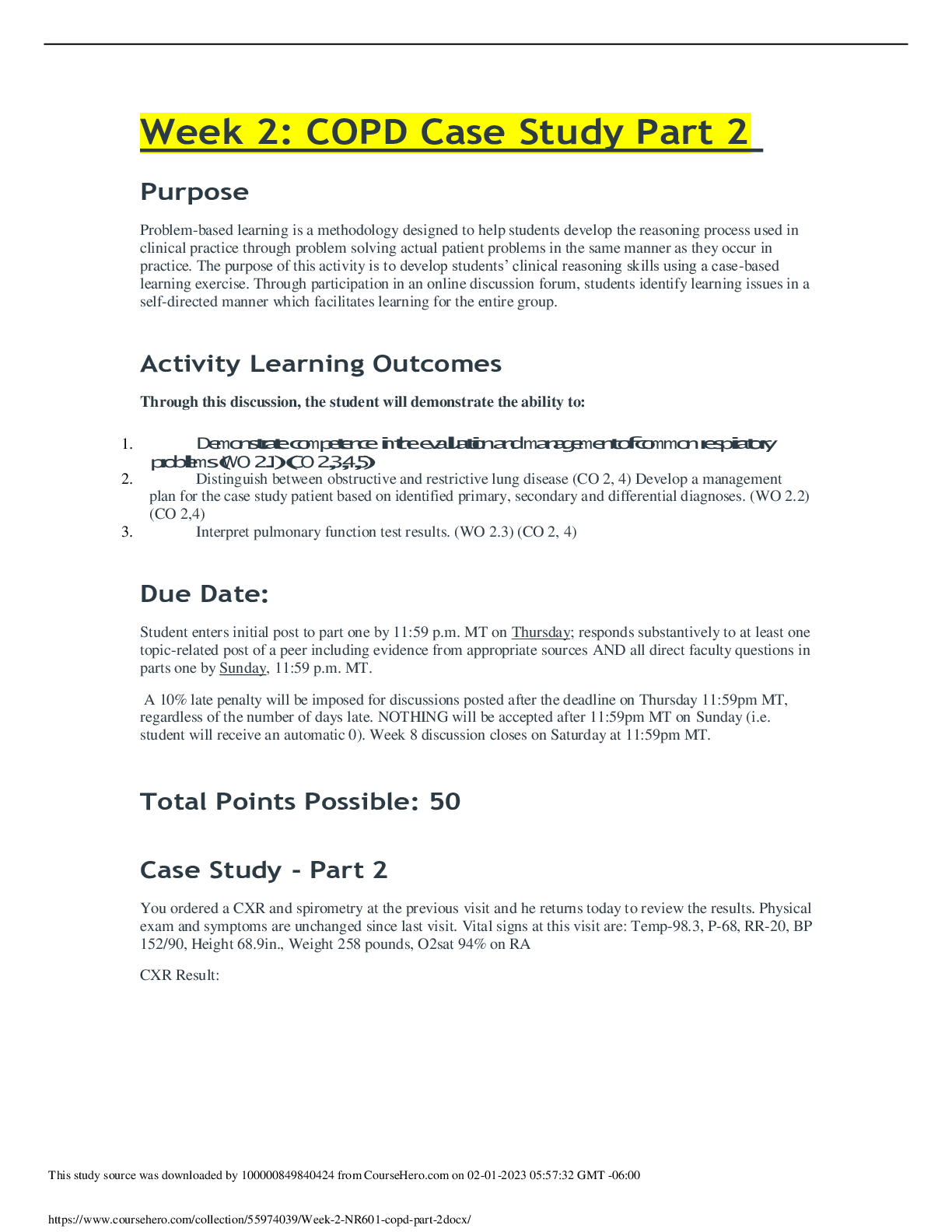


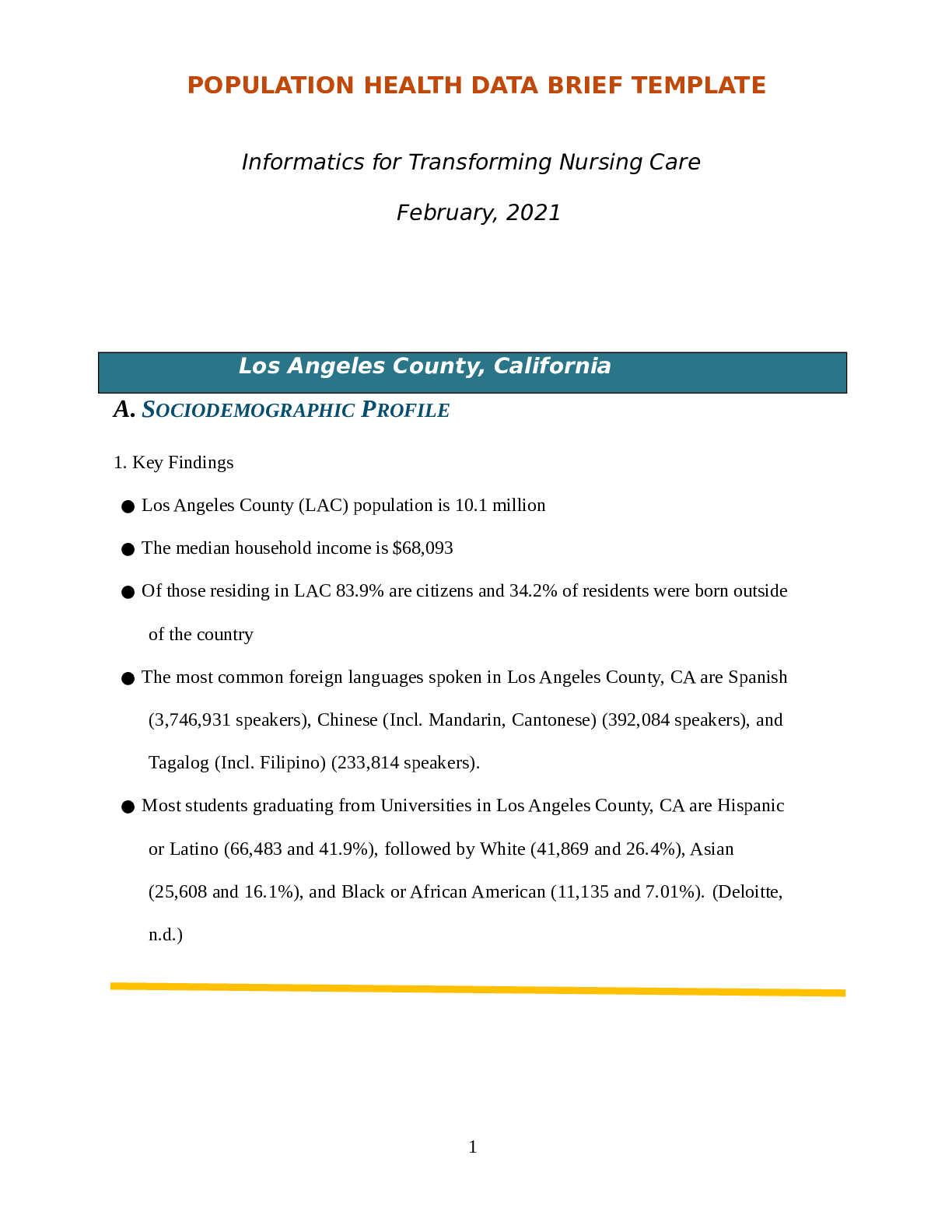







.png)



